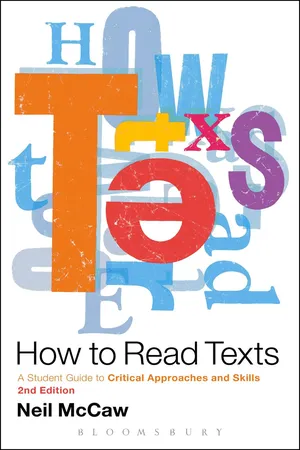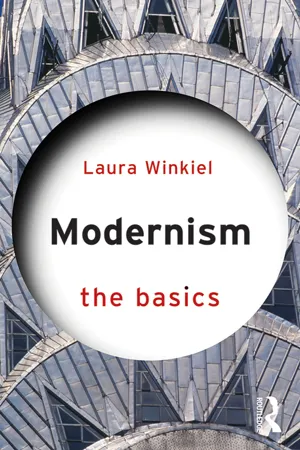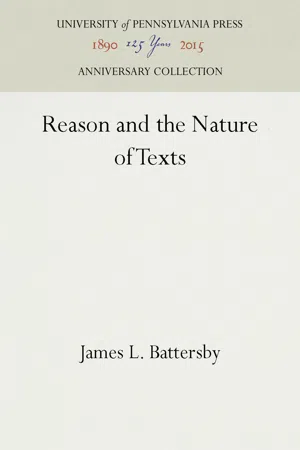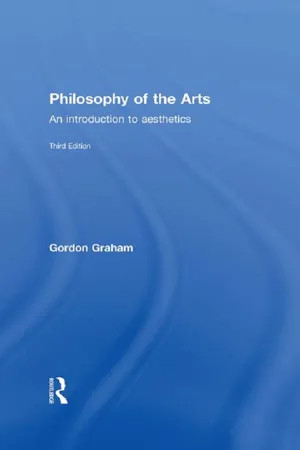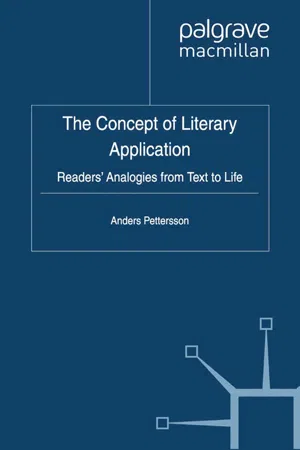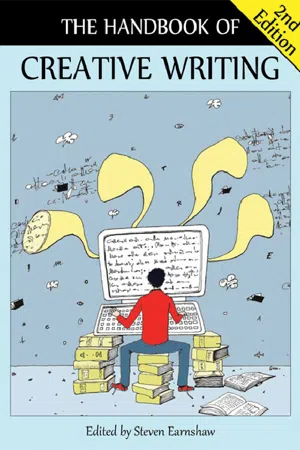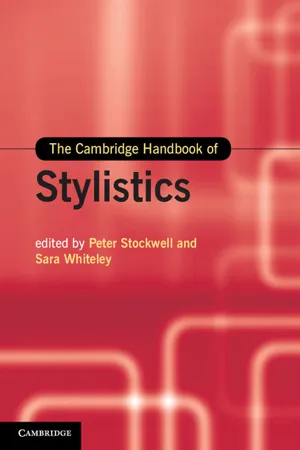Literature
Literary Form
Literary form refers to the structure and organization of a literary work, such as poetry, prose, drama, or other specific genres. It encompasses the way in which a piece of literature is written and presented, including elements like rhyme, meter, narrative structure, and style. Understanding the literary form of a work can provide insight into its meaning and impact.
Written by Perlego with AI-assistance
Related key terms
1 of 5
10 Key excerpts on "Literary Form"
- eBook - PDF
How to Read Texts
A Student Guide to Critical Approaches and Skills
- Neil McCaw(Author)
- 2013(Publication Date)
- Bloomsbury Academic(Publisher)
1 For Shelley, by considering the formal/genre context a reader gains a clearer under-standing of the way in which writers work and the process through which their writing takes shape. Just as in the twentieth century critics identified the notion of genre as one of the key ‘structures’ of literary history. In Northrop Frye’s Anatomy of Criticism (1957), for instance, Frye’s narratological approach focuses on the inner workings of what he sees as the four main genres of literature – comedy, tragedy, romance and satire – to uncover their underlying structural units. Therein he looks at individual texts but in an attempt to illustrate their position within the context of narrative (as a genre ) more generally. Just as Vladimir Propp’s The Morphology of the Folktale (1958) looks for patterns and recurring structures in the way prose narratives work, considering supposedly common elements of narrative such as story and plot (what he calls fabula and sjuzhet ). However, despite the fact that many critics have attempted to group texts in terms of genre , this does not always happen in the same way. Genre is sometimes ‘form’, at others ‘style’, and at others still a question of ‘purpose’. Which means that whilst ‘critic A’ might examine genre as the ‘form’ of poetry, ‘Critic B’ might see it as the ‘style’ of the ballad within the form of poetry, and ‘Critic C’ might analyse ‘protest’ verse within the style of the ballad within the form of poetry. Each of these critical discussions would be linked, but nevertheless each critic/ reader would be talking about genre in a different way. The result is that to this day there is no consensus about whether genre is a matter of form or style or tone or purpose or indeed subject matter, with critical readings of texts producing great variations as to how texts are grouped together, disagreements about where genre boundaries lie, and contradictions in how each text is interpreted. - eBook - ePub
- Laura Winkiel(Author)
- 2017(Publication Date)
- Routledge(Publisher)
orientation toward representing reality . When a writer decides to write in one of the available Literary Forms – fiction, poetry or drama – they accept that they will be restricted or limited “on the nature of possible aesthetic worlds” (Hayot 180). Fiction’s worlds tend to be materialist, detailed, and mimetic or closely imitative of reality. Poetry inclines to more intimate registers, appealing to the reader’s emotional and sensory perceptions. Drama’s constraint lies with the showing of events on stage rather than the telling of them, though sometimes storytellers appear on stage. As we’ll see in this chapter, each of these Literary Forms was fundamentally reworked by modernist writers to offer new ways of seeing and interpreting the world (Kern 2011: 2; see also Matz 2004). In effect, the massive historical, social and conceptual changes that occurred during the twentieth century were likewise felt in the transformation of Literary Form.An attentive reader will notice that our three chapters – “Concepts,” “Histories” and “Forms” – are really three facets of the same phenomenon of modernism. Each is necessary to the transformation of the other. Without sweeping historical changes, for instance, artistic form wouldn’t feel confined and artificial. We merely separate these aspects in order to make sense of one element at a time, but we should recognize that they mutually inform one another. In the epigram above, for example, German playwright and poet Bertolt Brecht states that the representation of reality is constantly changing and that artists cannot look to “existing works,” but should consider contemporary changes in philosophy, science, politics and everyday life in order to create artistic forms in which people can grasp what is occurring around them. Let’s see how this urge to alter Literary Form shaped modernist fiction, drama and poetry.Fiction
Fiction is a form of literature that includes the novel and the short story. While we will discuss some modernist short stories below, we will mainly focus on the novel. Unlike other Literary Forms such as lyric poetry and drama, the novel is primarily concerned with “particular people in particular circumstances” (Watt 15). Its characters have proper names, as if they were real individuals, and are usually ordinary people. Their lives are depicted through realism , a mode of representation whose aim is to present “a full and authentic report of human experiences [… by means of] a more largely referential use of language than is common in other Literary Forms” (Watt 32). By “referential use of language,” Watt means a kind of lifelikeness, or verisimilitude, a close correspondence between word and thing and between language and reality. But “close correspondence” does not imply that words can ever equal reality itself. As we’ve discussed in Chapter 2 - eBook - PDF
- James L. Battersby(Author)
- 2016(Publication Date)
Chapter 7 Genre: A Matter of Form, a Form of Matter This chapter is designed to fill out some of the suggestive remarks on genre presented in Chapter 1 and to serve as a prolegomenon to a theory of genres. As such it is concerned both with principles of generic differ-entiation and, most immediately, with certain common assumptions un-derlying casual and loose ways of talking about genres. As a means of getting rather directly to fundamental issues, I have chosen to focus on a few general remarks relating to genre in a book of popular criticism, Paul Fussell's Samuel Johnson and the Life of Writing} Fussell's remarks, though published aeons ago by the shelf-life standards of criticism today (when it seems that white bread lasts longer than the latest critical or theoretical fashion), are significant because they clearly exhibit widely held assumptions, at least among those who can borrow any time from gender, culture, and ideology studies to think about genre at all, and because they provide convenient access to matters especially relevant to the definition of genre and the identification of generic features of lit-erary texts. The following is divided into three sections. In the first, I deal with the notion that the recognition of a piece of writing as literature depends on a prior understanding of specific genre conventions, that subsumption by class is a prior condition of literary identification. The main object is to show that although nothing in particular can be understood without general concepts, the concepts upon which the assignment of literary status depends are not necessarily or regularly generic. The second sec-tion discusses broad problems involved in efforts to differentiate literary from non-literary composition. - eBook - ePub
Philosophy of the Arts
An Introduction to Aesthetics
- Gordon Graham(Author)
- 2005(Publication Date)
- Routledge(Publisher)
The use of sound and stress, word order, the distortion of grammar, accumulation of imagery and construction of multilayered language are all devices by which poetry may be said to reveal or show things, analogous to forms of reasoning by which an argument might show or an experiment uncover something. There are of course important differences, but it does not seem misleading to describe the devices identified here as means by which the mind is directed. To speak of poetry in this way is not to assume that what is revealed or demonstrated is incontestable, any more than a belief in the power of dialectic to lead us to the truth implies that every argument must supply a conclusive demonstration of the thesis it means to support. We can be led in many different and competing directions by arguments and experiments which all claim validity, and so too we may expect poetic revelation to throw up a variety of images for our consideration. But enough has been said to establish the claim that poetic form is not just an agreeably ornamental way of saying things whose truth or substance is to be established in some other way. The relation between what is said in poetry and how it is said can be more intimate than that.However, even if it is accepted that poetry as a form of understanding does not yield to paraphrase without significant loss there is a further question for this chapter to address: can the same be said of the other literary arts? The poetic forms described and discussed so far are closely connected with ‘poetry’ narrowly understood. Other literary arts have other forms, and it needs to be shown that these are also ways of directing the mind to a better apprehension of some aspect of human experience. Can storytelling, whose form is narrative, be used in this way?Narrative and fiction
The device of multilayered representation is to be found in novels as well as in poetry. A striking counterpart in this respect to Browning's My Last Duchess is Kazuo Ishiguro's novel The Remains of the Day , subsequently made into a highly successful film. Ishiguro's story is set in the England of the 1950s. The principal character is a butler, Stevens, who takes a few days' holiday motoring across the countryside with the ultimate purpose of seeking out a former colleague. The journey provides the occasion and the context for extended reminiscences of previous, rather more glorious periods of service. The story is told in the first person from the butler's point of view and, to a degree, Stevens reminisces in order to construct an apologia - eBook - PDF
The Concept of Literary Application
Readers' Analogies from Text to Life
- Anders Pettersson(Author)
- 2012(Publication Date)
- Palgrave Macmillan(Publisher)
However, we do not necessarily have to attach much importance to the popular understand- ing of what the word “literature” stands for. We can find “literature” defined more authoritatively in dictionaries and encyclopaedias, even 194 The Concept of Literary Application though these definitions, too, are of course fallible. Let us look at a cou- ple of examples. The Oxford English Dictionary defines “literature”, in the relevant sense, as writing which has claim to consideration on the ground of beauty of form or emotional effect 26 This is the corresponding definition in Webster’s Ninth New Collegiate Dictionary: writings in prose or verse; esp : writings having excellence of form or expression and expressing ideas of permanent or universal interest 27 For good measure I also quote the definition in The American Heritage Dictionary: Imaginative or creative writing, especially of recognized artistic value 28 The definitions certainly differ, but they can perhaps be said to agree at least in spirit. They all picture literature as something fine (speaking of it in terms of “beauty”, “excellence”, “value”), and they all contain quite explicit statements of the criteria for qualifying as literature. However, the criteria are vague – literature should distinguish itself through “emotional effect”, “beauty of form”, “ideas of permanent or universal interest”, or suchlike – and this means that the question of the extension of the concept, of what specific texts fall under the concept of literature, remains quite open. (Do Cicero’s letters to Atticus have claim to consideration on the ground of beauty of form or emotional effect? Can Wittgenstein’s Philosophical Investigations [Philosophische Untersuchungen, 1953] be said to express ideas of permanent or universal interest?) It is worth noting that the criteria are also rather diverse. - eBook - PDF
- Steven Earnshaw(Author)
- 2014(Publication Date)
- Edinburgh University Press(Publisher)
19 What is Form? W. N. Herbert Iambic pentameter. There now, I’ve said it. Please form an orderly queue to flee from this chapter. What other two words in the poetry world excite such intimidation, boredom, cantankerousness and, yes, passion? (Though ‘reluctantly rejecting’ or ‘talentless guff’ may come close.) ‘Iambic pentameter’ gives off the musty scent of the academy, with perhaps a topnote of formaldehyde – it’s Greek, for God’s sake, though apparently not in the way ‘ouzo meze parakalo’ is Greek. And it functions as shorthand for a host of terrors: metre, stress, stanza, and above all, form. Form consists of all the structural conventions within which most poetry in English has been written inside and outside the last hundred years. It is to the aspiring practitioner of literature as theory is to its critic. It is also the undisputed hero of this essay, even if it is an abstraction. Whether you are a new writer approaching this issue for the first time, a resolute anti-formalist, or someone in their seventh year of fruitless struggle with the trochee, you are haunted by form. If you haven’t got to grips with it, says that over-familiar inner voice, then you’re not serious about this whole poetry business. If your inner voice happens to be Baudelaire, he’s even blunter: ‘I pity the poets who are guided solely by instinct; they seem to me incomplete’ (Auden 1987: 53). If you go to writers’ groups, you’ll find that form bores proliferate with their coronets of sonnets or praise of the amphibrachic foot. You’ll also find their opposites are just as bonkers about their anti-academic performance schtick, their aleatoric principles for gen-erating text, or their Old Believers-type devotion to the ampersand. The temptation to shrug it off, to keep shrugging it off, seems entirely natural; to concentrate instead on the intricate, careful work of giving each poem its own combination of music and structure, according to one’s own principles of rhythm and discipline. - eBook - PDF
- David Davies(Author)
- 2007(Publication Date)
- Continuum(Publisher)
In this sense, writings on shampooing carpets are most unlikely to qualify as literature , while Hamlet , War and Peace , and The Decline and Fall of the Roman Empire might be offered as paradigm cases that do so qualify. But here again we need to distinguish different senses in which certain writings can count as literature in this narrower sense. Often, when questions are raised about the nature of literature, our interest is in delimiting those writings that might be studied in courses on literature taught in Arts faculties at colleges and universities, analogous to the task of delim-iting those daubed canvasses that might be studied in college courses on visual art. To be literature, in this sense, is to be a literary artwork. We may term this the artistic sense of the term. To ask about the nature of literature in the artistic sense is to ask what makes a piece of writing a literary artwork. What we are now seeking is a principled distinction between novels, poems, and plays, for example, and scien-tific articles, biographies, essays, comics, and advertising material. This is indeed a distinction that has interested many writers, and it is literature in the artistic sense that we tried to define ‘extensionally’ by offering examples. But the term ‘literature’ is also often used evaluatively in what we may term the extended sense, to include not only literary artworks but also writings in non-artistic genres – travel writing, essays, some works of philosophy and history – that are taken to share with literary artworks some of the qualities for which the latter are valued. It is in this sense that Terry Eagleton cites, as examples of seventeenth-century English literature, not just the works of Shake-2 AESTHETICS AND LITERATURE - eBook - PDF
- Peter Stockwell, Sara Whiteley(Authors)
- 2014(Publication Date)
- Cambridge University Press(Publisher)
Part II Literary concepts and stylistics 8 Genre Beatrix Busse Introduction Genre analysis is a crucial component of both literary and linguistic investigations. Genres may be defined as different categories of texts which are determined by both formal and functional criteria (Jucker and Taavitsainen 2013). In other words, genres unite certain repetitive and generalisable features because their users in turn share certain goals and are prone to using a specific genre over and over again. In most cases, genres have labels, such as epic, limerick or sonnet, which are genres of poetry, or textbook and review, which are genres of academic discourse. Another example would be recipes – medical and culinary – which have retained many of their prototypical features throughout the history of English. Due to the fact that their purpose is to instruct us in how to make medicine or prepare food, they show, for example, a high number of imperative structures containing the verb take (Jucker and Taavitsainen 2013). Existing linguistic definitions, especially, show some variety in the ways they define genre (Moessner 2001: 131). Genres may be seen as instru- ments for text classification and as ‘cultural products and social forms of communication, conditioned by their time and social setting’ (Jucker and Taavitsainen 2013). Genres and genre development have always been dynamic and procedural, as they may show variation and intertextuality in function and in linguistic realisations (Corbett 2006). Both literary and non- literary genres entail the possibility of changes: new genres and their features evolve and others disappear. Contextual factors mark and create the ways in which genres change over time and they interplay with the processes of making texts as well as processing them. - eBook - PDF
Literature, Ethics, and Aesthetics
Applied Deleuze and Guattari
- S. Achilles(Author)
- 2012(Publication Date)
- Palgrave Macmillan(Publisher)
Literature is also involved with interdisciplinary study, in cultural, historical, and psychoanalytical contexts. The study of literature and trauma is such an example. This book brings to this sumptuous feasting upon literature a concept referred to as the literary function; it takes the literary aside for a moment to consider it in its own terms and not as representation, nor as therapy, nor, indeed, as Gilles Deleuze and Guattari have dealt with “the work of art,” 2 as percepts 2 LITERATURE, ETHICS, AND AESTHETICS and affects. Affect in their book What Is Philosophy? (1994) is thought in terms of intensity prior to ourselves. Rather, the concept developed in this work explores the literary aesthetic as performing acts, as producing affects, and by “affect” is meant an expression of a body that is the result of an action and that does not precede the action. 3 Contrary to the notion of the work of art existing “in itself,” 4 the literary function is explored for the way in which it performs an ethics of self—that includes a concern for the self, to borrow Foucault’s expression. This self is made in the act of the literary function. Here, self, language, and the world are continuous and inseparable. In developing this conceptual tool for the aesthetic, this book also brings a pedagogy to both literary study and creative writing practice. 5 Since its inclusion within the academy, around fifty years ago, 6 creative writing has struggled to find its own pedagogical bearing. Narratological approaches, which atomize the piece of creative writing into various parts such as genre, plot, character, tone, setting, theme, voice, and so on, add little understanding of the craft that is not predetermined. 7 At times, creative writing classes proceed in an anecdotal style as writers “talk” about their own and other writers’ processes and experience of writing and reading. At best this discussion is circular and at worst, off the point. - eBook - PDF
The Laghukatha
A Historical and Literary Analysis of a Modern Hindi Prose Genre
- Ira Valeria Sarma(Author)
- 2013(Publication Date)
- De Gruyter(Publisher)
146 Literary analysis tion is mostly avoided, not least to comply with the genre's demand for brevity. As a result the majority of laghukathäs - especially those of public and societal life - lack distincdy in atmosphere and thus address the reader once more on a rational rather than an emotive level. The reader is forced to concentrate on the message in a very blunt and matter-of-fact way, especially in the place- and spaceless laghukathä which leaves the action — mostly consisting of pure dia-logue — in a vacuum. Where place or space are indicated direcdy or indirecdy, they often have a significant symbolic or philosophical dimension. The symbolic value of various places is emphasised by the fact that the spatial determination is revealed only towards the end of the story and thus coincides with the climax. An important aspect of the sym-bolism of space in the laghukathä is furthermore that space, in many cases, must be read as social space. Social intrusion, exclusion and demarcation are reflected in the spatial arrangements in the laghu-kathä, underlining the social concern of the writers. 4.4 Form In literature the term 'form' may refer to two aspects, the outer form or 'shape' of a text and its inner form or 'structure'. While the shape of a text is apparent to the reader at first sight, the text's structure either organises the story without becoming obvious to the reader, or - if easily discernible - reveals itself only gradually during the reading-process. Both structure and shape are important means for the writer to communicate with the reader, to raise expectations, lead the reader through the story and produce the desired effect. In the following, the outer and inner form of the laghukathä and their mutual influence will be investigated and we will see how formal aspects of the laghukathä are employed to produce a particular im-pression.
Index pages curate the most relevant extracts from our library of academic textbooks. They’ve been created using an in-house natural language model (NLM), each adding context and meaning to key research topics.
